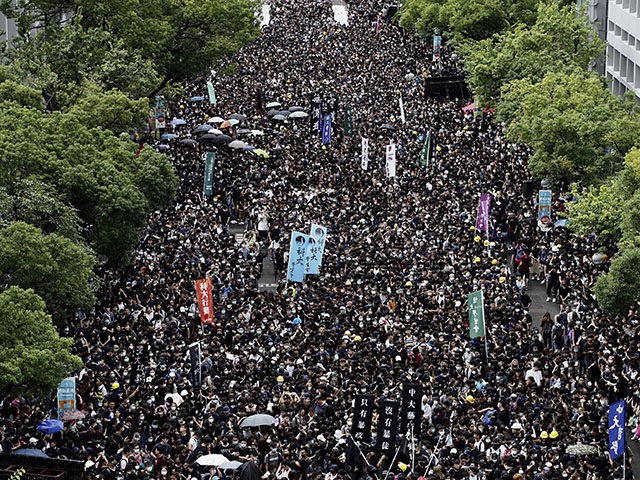Schools Become Hong Kong Protest Battleground as S
Post# of 65629

< >

Thousands of secondary school and college students in Hong Kong announced they would skip classes on Monday, the first day of the new school year, essentially staging a “strike” and adding their numbers to ongoing protests.
The schools from which Hong Kong Chief Executive Carrie Lam and Police Commissioner Stephen Lo graduated are among those affected by the student strike.
Some of the students held demonstrations right in front of their schools, as reported by the South China Morning Post:
At St Francis’ Canossian College, the Wan Chai alma mater of Chief Executive Carrie Lam Cheng Yuet-ngor, six students donning yellow helmets, goggles and masks knelt in front of the entrance and held placards bearing anti-government messages. They said they hoped Lam would listen to their voices and agree to the protesters’ key demands, including the full withdrawal of the extradition bill.
Elsewhere, some 50 students at Ying Wa College in Sham Shui Po, the oldest secondary school in Hong Kong, staged a rally outside the school gates, putting up posters with anti-government messages.
Leading chants of “Liberate Hong Kong; revolution of our times”, Bowie Tang, a Form Six student and convenor of the school’s extradition bill concern group, said a full walkout from classes would begin on Tuesday.
He estimated 30 students would boycott Monday’s opening ceremony and sit at the basketball court.
“The school only approved our planned class boycott tomorrow at our school hall,” he said. “But I am willing to take any disciplinary consequences since I am already taking little risks by not standing at the front line out on the streets today.”
The protest movement has called upon students to skip school every Monday for the duration of the crisis, a possibility school administrators reportedly view with unease. Some student leaders have said they plan to boycott classes every day for the next two weeks.
Riot police were deployed to several schools, including the alma mater of Lo. Some school administrators urged students to call off planned rallies in the interest of public safety, but the demonstrations reportedly remained peaceful. Some students and school administrators criticized the police presence as an effort at intimidation, especially when the police began searching the student demonstrators and confiscating protest materials.
Hong Kong Chief Secretary for Administration Matthew Chung Kin-chung held a press conference on Monday in which he said the police were deployed because some protesters tried to prevent students who were not participating in the strike from entering schools.
“The police presence is meant to ensure public safety and should not be seen as ‘white terror,’” said Education Secretary Kevin Yeung Yun-hung, referring to the increasingly common comparison of China’s effort to quash the Hong Kong protest movement with a notorious period of political repression a century ago.
Chinese state media strove to portray the school strikes as a failure and implied the students who did participate were pressured into doing so over the summer. China’s state-run Global Times quoted school principal and Hong Kong Federation of Education Workers President Wong Kam Leung slamming the student boycott as unpatriotic and advising other administrators to take a firm hand with the students to shut down demonstrations.
“The protests are very complicated and have showed signs of terrorism. The involvement of underage students will not help solve the problem, but put them in danger. To protect their normal studies and safety, Hong Kong society should prevent underage students from participating in strikes and political movements,” the Global Times quoted Hong Kong Association of Young Commentators Vice Chair Victor Chan warning.
The SCMP said police officers are giving their own children portable alarms and watching for efforts to harass or intimidate them. Hong Kong officials claim they have received over 1,600 complaints about the personal information of police officers being posted online, sometimes including the names of the schools attended by their children.
Students at Chinese University mustered enough demonstrators to fill the sizable mall area on university grounds and read a joint statement calling on Hong Kong’s government to concede the five core demands made by the protest movement.
“Be it bullets, be it white terror, be it the totalitarian regime, whatever obstacles stand in our way shall never be enough to break our determination,” the students’ joint statement said.
Responding to charges from Beijing loyalists that Chinese University has become a “school for rioters,” student union president Jacky So Tsun-fung declared, “If going against an evil law and tyrannical rule gives us the name of rioters, we gladly accept.”
So said the rally drew approximately 30,000 participants and described university staff as “cooperative,” if not supportive.
Younger students said participating in the student strike was the most effective way they could demonstrate their support for the protest movement. “We’re very disappointed in Carrie Lam and embarrassed to be her successors,” said one 13-year-old attending Lam’s old school, St. Francis’ Canossian College.
“Lots of students in our school pretend nothing has happened and won’t talk or do anything about the situation. Those who come out today are already prepared for the risks. If we don’t use our voices, we may never have the chance to do so again,” said another young student.
Some of the university students donned protective gear for their rallies, either to remind onlookers about excessive police force against street demonstrators or to protect themselves in the event the police decided to storm their campuses. One student demonstrator told Radio Television Hong Kong she feared that if the protest movement fails, Hong Kong will end up like Xinjiang, the mainland province where Communist China has herded millions of Muslims into concentration camps for political indoctrination.
 (0)
(0) (0)
(0)